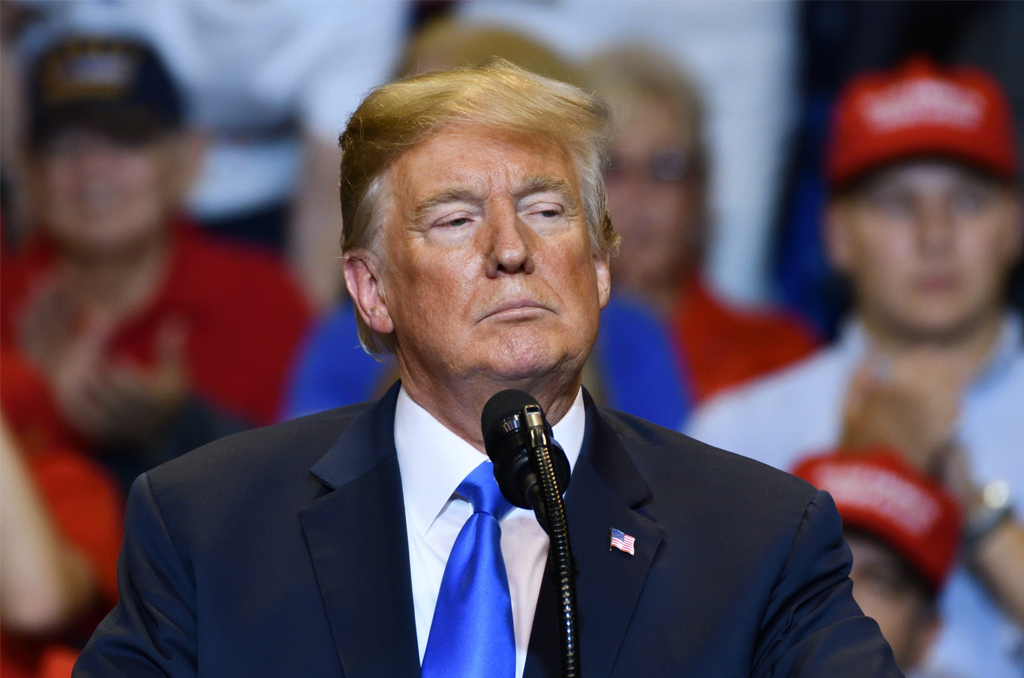Courtesy: Evan El-Amin- Shutterstock- WILKES-BARRE, PA – AUGUST 2, 2018: President Donald Trump with a serious look as he delivers a speech at a campaign rally held at the Mohegan Sun Arena.
With over three-quarters of the vote, former President Donald J. Trump easily won Florida’s presidential preference primary on Tuesday. However, his vote total was less than a quarter of a million votes less than what he received here four years prior, when he had only nominal competition.
With Democrats opting not to host a primary and Trump having enough delegates before the polls started to secure the Republican candidacy at a convention later this summer, Tuesday’s presidential vote was exclusively a Republican contest.
Nevertheless, 1.1 million people cast ballots throughout the state, with over 12,000 of them doing so in Leon County.
During a speech on Wednesday in Miami Beach, Governor Ron DeSantis essentially declared that Florida’s standing as a swing state was over. He stated that this election year, “you won’t see a lot of (campaigning) activity” in the Sunshine State, which is now a dependable red state, nor would TV viewers see “a lot of ads.”
Three points to consider regarding this year’s presidential preference primary are as follows:
Was this March only a warm-up for November?
Election turnout was 21.5 percent across the state. More over 23 percent of eligible voters in Leon County, or roughly 6 percent of the county’s 197,000 registered voters, cast ballots, outperforming the state average.
Participating voters gave election workers, candidates, and party leaders a chance to brush off cobwebs and prepare for the fall election in a manner similar to spring training.
The only problem that has surfaced is the growing difficulty in locating poll workers. Although it’s not an issue for this election, Mark Earley, the Leon County Supervisor of Elections, noted that it might be something we have to deal with come autumn.
Less than twenty vote-by-mail ballots were turned in at the Leon County Election Center on Apalachee Parkway at noon on Tuesday. That drop-off box was staffed by Robert Feuerstein, who has worked every election since relocating to Tallahassee from California in 2018.
In November, Feuerstein said, “it won’t be like this.” “We’re going to be busy come November. We’re going to burn.
Is a Trumpian trend line starting to emerge?
A closed primary system with 58 counties hosting Republican elections only offers a semblance of what trustworthy GOP voters are thinking.
Trump’s 81% of the vote, a 12-point decrease from the 2020 primary, gives Democrats fodder for their autumn campaign.
Nikki Fried, the leader of the Florida Democratic Party, said on Wednesday morning that almost 20% of voters who cast ballots in Trump’s adopted state on Tuesday did so as a protest.
“Florida is a troubled state for Donald Trump,” Fried declared. “The main findings from last night indicate that he is weak and becoming weaker every day—not just in Florida, but all throughout the nation.”
Even by Trumpian standards, the former president had a busy week leading up to election day. His associates grabbed control of the RNC, dismissed all senior staff members, and installed Trump supporters in their stead. His daughter-in-law was named co-chair.
The Florida vote was similar to the outcomes of the primaries in Illinois, Ohio, and Kansas that were held on the same day; between 20% and 25% of voters chose a candidate other than Trump, despite the fact that he had enough delegates to be the front-runner.
Compared to his 87% triumph in Alaska on Super Tuesday, the 80% victory in Florida was less. Haley was still in the race at that point.
It is less than the 93% he earned four years ago when he faced minimal opposition in the Florida presidential preference primary, and it is about 20 points less than the 97% he received on March 12 in Hawaii.
What is the significance for November?
That’s not much, experts say.
The uniqueness of the March 19 vote contributed to the poor turnout throughout the state. Due to the lack of a Democratic primary, only Republicans were allowed to cast ballots in 58 of the 67 counties in Florida, which is a closed primary state.
Additionally, voting became primarily a symbolic gesture because Trump was the presumed nominee of the Republican Party.
Former Leon County commissioner Bruce Host said after casting his ballot, “I voted because I always vote.”
Over 60 percent of Florida voters are not registered as Republicans and hence were unable to cast ballots, so there is not much to be gained from this election despite the fact that 1.1 million voters cast ballots, or roughly 8 percent of the state’s total registered voters.
According to political scientist Aubrey Jewett of the University of Central Florida, “it is also not significant for the general (election) because primary elections are mostly about the competition,” and there was none this time.
Though he is skeptical of how successful it will be, Jewett stated that the significance of many Republican voters rejecting Trump will give Democrats campaign fodder.
The one thing that has caught my attention since 2016 is how deeply Trump’s fans feel about him. They have repeatedly shown that they will support Donald Trump in spite of all of his difficulties and problems.
Stories that matter are our priority. At Florida Insider, we make sure that the information we provide our readers is accurate, easy-to-read, and informative. Whether you are interested in business, education, government, history, sports, real estate, nature or travel: we have something for everyone. Follow along for the best stories in the Sunshine State.
Chris began his writing as a hobby while attending Florida Southern College in Lakeland, Florida. Today he and his wife live in the Orlando area with their three children and dog.

